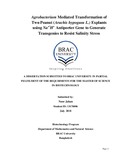| dc.contributor.advisor | Islam, Dr. Aparna | |
| dc.contributor.author | Jahan, Noor | |
| dc.date.accessioned | 2019-01-02T05:07:51Z | |
| dc.date.available | 2019-01-02T05:07:51Z | |
| dc.date.copyright | 2018 | |
| dc.date.issued | 2018-07 | |
| dc.identifier.other | ID 13176006 | |
| dc.identifier.uri | http://hdl.handle.net/10361/11063 | |
| dc.description | This thesis is submitted in partial fulfilment of the requirements for the degree of Bachelor of Science in Biotechnology, 2018. | en_US |
| dc.description | Cataloged from PDF version of thesis. | |
| dc.description | Includes bibliographical references (page 68-76). | |
| dc.description.abstract | Peanut is one of the most popular sources of healthy addible oil. Its susceptance to various biotic and abiotic stresses is limiting crop production worldwide. Salinity is prior to them. Moreover, it is strictly monocious and geocarpic in nature. For these reason traits development through conventional breeding is almost impossible. So, Transformation is the only potential way to introduce stress tolerance gene in the trait of peanut. Here transformation done with two vector pK7WG2_AtNHX1_1.6 and pK7WG2_OsNHX1_1.6 mediated by Agrobacterium tumefaciencce. Decapitated whole embryo and Decapitated half embryo were used as explants. Four local peanut varieties named BINA Chinabadam 2,BINA Chinabadam 3,BINA Chinabadam 4, and BINA Chinabadam 6 used in this study. Regeneration media with 2 mg/l BAP supplement was found best for maximum number of shoot formation. The parameters for transformation like optical density, infection time, co-cultivation period optimized for all the varieties. For decapitated whole embryo transformation with bacterial solution OD6001.0-1.3 with infection time 15 hr without co-cultivation period showed higher regeneration response under selection for all verities. For decapitated half embryo transformation with bacterial solution OD600 1.0-1.2 with infection time 90 min followed by 48 hr of co-cultivation period showed higher regeneration response under selection pressure. Regeneration frequency of putatively transformed plantlets appeared more than 65% under selection whereas non transformed plants gave no regeneration under selection pressure. Kanamycine concentration of 100 mg/l found to be efficient for this purpose. Transformant detection was carried out in three distinct way antibiotic selection, leaf disk senescence assay and rooting under salt stress. The putatively transformed plants obtained after transformation observed to tolerate up to 100mM of salt stress, which was 50mM higher than base line salinity stress level. This study offers further study to establish salt tolerant peanut variety. | en_US |
| dc.description.statementofresponsibility | Noor Jahan | |
| dc.format.extent | 76 pages | |
| dc.language.iso | en | en_US |
| dc.publisher | BRAC University | en_US |
| dc.rights | BRAC University theses are protected by copyright. They may be viewed from this source for any purpose, but reproduction or distribution in any format is prohibited without written permission. | |
| dc.subject | Agrobacterium | en_US |
| dc.subject | Peanut | en_US |
| dc.subject | Arachis hypogaea L. | en_US |
| dc.subject | Salinity stress | en_US |
| dc.title | Agrobacterium mediated transformation of two peanut (Arachis hypogaea L.) explants using Na⁺/H⁺ antiporter gene to generate transgenies to resist salinity stress | en_US |
| dc.type | Thesis | en_US |
| dc.contributor.department | Department of Mathematics and Natural Sciences, BRAC University | |
| dc.description.degree | B. Biotechnology | |

